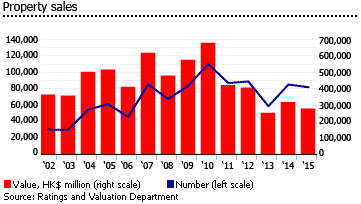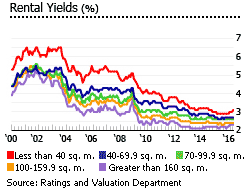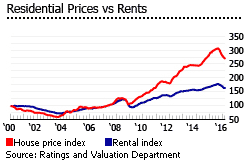Hong Kong property prices are now in free fall
 Hong Kong’s residential property price index dropped 7.31% (-9.91% inflation-adjusted) during the year to end-Q1 2016, a sharp turnaround from an annual increase of 19.61% (-14.62% inflation-adjusted) during the same period last year, according to the Ratings and Valuation Department (RVD). In fact, it was the steepest y-o-y decline in almost seven years. Quarter-on-quarter, residential property prices fell by 5.19% (-5.93% inflation-adjusted) in Q1 2016.
Hong Kong’s residential property price index dropped 7.31% (-9.91% inflation-adjusted) during the year to end-Q1 2016, a sharp turnaround from an annual increase of 19.61% (-14.62% inflation-adjusted) during the same period last year, according to the Ratings and Valuation Department (RVD). In fact, it was the steepest y-o-y decline in almost seven years. Quarter-on-quarter, residential property prices fell by 5.19% (-5.93% inflation-adjusted) in Q1 2016.
Surprisingly, smaller-sized properties had the biggest price falls. Prices of apartments smaller than 40 sq. m. plunged by 14.3% during the year to Q1 2016, and apartments 40-69.9 sq. m. dropped by 10.9%. Prices of apartments 70-99.9 sq. m. rose by a meager 0.7%, while prices of apartments 100-159.9 sq. m. declined by 6.7%. On the other hand, apartments with sizes bigger than 160 sq. m. were relatively unscathed, with prices rising by 8.6% y-o-y in Q1 2016.
“The current downward trend in the housing market did not have much impact on ultra-luxury properties,” according to Colliers International. “Prices for trophy properties continued to hover near record levels in Q1 2016.”
AVERAGE HOUSE PRICES, MARCH 2016 |
||||||
| AVERAGE PRICES (HK$/sq. m) | YEAR-ON-YEAR CHANGE (%) | |||||
| PROPERTY SIZE | HONG KONG | KOWLOON | NEW TERRITORIES | HONG KONG | KOWLOON | NEW TERRITORIES |
| Less than 40 sq. m | 127,623 | 102,614 | 93,932 | -14.3 | -8.8 | -10.4 |
| 40 – 69.9 sq. m | 133,983 | 110,644 | 85,935 | -10.9 | -7.8 | -7.1 |
| 70 – 99.9 sq. m | 167,872 | 148,204 | 93,019 | 0.7 | 6.9 | -9.4 |
| 100 – 159.9 sq. m | 176,934 | 178,276 | 89,612 | -6.7 | -4.2 | -6.6 |
| Greater than 160 sq. m | 246,996 | 192,067 | 84,582 | 8.6 | NA | 3.2 |
| Source: Ratings and Valuation Department (RVD) | ||||||
Hong Kong’s residential property market has risen relentlessly for several years. From 2008 to 2013, house prices skyrocketed by 134% (95.7% inflation-adjusted), driven higher by a flood of money from developed markets’ central banks in the wake of the global financial crisis. However, the market slowed sharply in the first half of 2014, with house prices rising only by 2.9%, due to government cooling measures. But the housing market bounced back quickly in the second half of 2014, with prices rising by 8.2% in Q4 2014, 14.6% in Q1 2015, 16.9% in Q2 2015, and 12.7% in Q3 2015. Hong Kong’s currency peg to the dollar kept borrowing costs near record lows, fuelling continued property demand.
However, the housing market has slowed sharply in the past several months mainly due to the sharp decline in the flow of money following the intensification of government crackdowns on the wealthy in Mainland China. Worse, other factors are now aggravating the situation, including the following:
- the increase in housing supply;
- intensified competition from other global cities like Tokyo, Singapore or London;
- Hong Kong’s economic slowdown;
- the potential interest rate rise in the U.S. this June 2016, and;
- the continuing implementation of government cooling measures.
The country’s housing market is expected to remain down in the coming months, amidst anemic demand for new developments and low sales transactions. House prices are projected to drop by around 10% this year, according to Colliers International. On the other hand, Goldman Sachs projects that HK house prices would fall 20% in the next two years, as Fed hikes interest rates.
“We do not expect a sudden collapse but they [house prices] could fall by as much as 30% over the next three years,” according to Colliers International.
Hong Kong’s economic growth slowed sharply to 0.8% during the year to Q1 2016, from an annual growth of 2.1% in the same period last year, mainly due to decline in tourist arrivals and falling retail sales. Hong Kong’s economy is expected to grow by around 1% to 2% this year, after 2.4% in 2015, 2.6% in 2014 and 3.1% in 2013, according to Financial Secretary John Tsang Chun-wah. The International Monetary Fund (IMF) is more optimistic, projecting the HK economy to grow by 2.2% this year.
Hong Kong property market remains the world’s most unaffordable
In 2009, while property prices were taking a nosedive across the U.S., Hong Kong’s housing market was going into overdrive.
- In 2009, residential property prices surged by 28.5% (26.5% inflation-adjusted)
- In 2010, house prices rose by 21% (17.7% inflation-adjusted)
- In 2011, house prices rose by 11.1% (5.1% inflation-adjusted)
- In 2012, property prices skyrocketed by 25.7% (21.2% inflation-adjusted)
- In 2013, property prices rose 7.7% (3.3% inflation-adjusted)
- In 2014, property prices rose 13.6% (8.2% inflation-adjusted)
- In 2015, property prices rose by just 2.4% (0.1% inflation-adjusted)
Hong Kong’s property market remains the world’s most unaffordable, according to the Demographia International Housing Affordability Survey of January 2016. Average home prices were 19 times gross annual median household income in 2015, up from 17 times in 2014 and 12.6 times in 2013 and the highest level ever recorded in the survey’s 12-year history.
Based on UBS Real Estate Bubble Index released by end-2015, Hong Kong’s housing market is dangerously overvalued and house price levels are “fundamentally unjustified”. Accordingly, house price increases in Hong Kong are driven more by local and global investment demand, rather than local household earnings.
Hong Kong is the world’s second most expensive city for expatriates to live in, according to Mercer’s 2015 Cost of Living Survey, and the most expensive in the Asia Pacific.
Housing demand has been propelled by a combination of stringent government regulations on development, low interest rates, and currency stability; while the supply of land, which the government controls, continues to diminish.
Government keeps housing market curbs despite falling house prices
Hong Kong’s government has attempted to lean against the property price rises in recent years, with the following measures:
- In November 2010, the government imposed a ´flip tax´ of 15% on properties resold within six months, and doubled stamp duties to 8.5% on properties worth HK$20 million (US$2.6 million) or more.
- On October 26, 2012, the government introduced a Buyer’s Stamp Duty (BSD), imposing a 15% tax on property purchases made by foreigners.
- In February 2013, the government doubled the stamp duty on all property transactions worth more than HK$2 million (US$257,902), though this measure ended in May 2014.
- In April 2013, the Residential Properties (First-hand Sales) Ordinance which aims to shield buyers from dishonest sales practices came into full effect.
- In May, 2014, the government proposed to relax the "six-month" timeframe for owners who wish to upgrade their flats. Homebuyers do not need to pay DSD if their old unit is sold within six months of signing a formal agreement.
- In February, 2015, the government required buyers of self-used residential properties valued under HK$7 million (US$900,000) to make larger down payments, after previous rounds of cooling measures aimed at more expensive housing spurred demand for smaller properties.
Despite diving house prices, the government recently indicated that it would keep its rein on the property market so long as uncertainty in the local economy and investment markets remains.
“When we launched stamp duty to curb the overheating property markets, prices had risen sharply,” Secretary for Financial Services and the Treasury Chan Ka Keung said. “It will take time for the government to assess if market conditions have really changed to enable us to relax these measures. It is too soon to make a decision.”
Property sales plunging
The number of property transactions plummeted by 63% y-o-y to just 6,221 in the first quarter of 2016, based on RVD figures, while sales values dropped 61% y-o-y to HK$44.68 billion (US$5.75 billion) over the same period.

In March 2016:
- Primary market property sales plunged by 54% y-o-y to just 698 units, while total transaction values fell by 55% to HK$3.13 billion (US$400 million).
- Secondary market property sales dropped 45% y-o-y to just 2,477 units, while transaction values fell by 48% to HK$8.04 billion (US$1.03 billion).
“With the cooling measures remaining in place, sales in the primary and secondary market will continue to be sluggish,” said Louis Chan Wing-kit of Centaline Property Agency.
Interest rate hikes

Hong Kong’s currency has been pegged at circa HK$7.8 per U.S. dollar since October 1983, which has the result that Hong Kong’s monetary policy is largely outsourced to the U.S. Federal Reserve. When the Federal Reserve increases interest rates, Hong Kong’s interest rates will most likely increase as well.
The Hong Kong Monetary Authority (HKMA) lifted its base rate by 25 basis points to 0.75%, following the Fed’s move to raise the fed funds rate in December 2015. Despite this, local banks in the country decided to keep their current interest rates. In April 2016, the best lending rate remained unchanged at 5%. It dropped from 5.25% to 5% in December 2008, when the Fed Funds rate declined from 1% to 0.13%, and has been unchanged since then.
In March 2016, the average interest rate on new mortgage loans approved with reference to best lending rate stood at 12.6%, down from 14.2% in the previous month but slightly up from 12.5% in the same period last year.
New mortgage lending plunging
In March 2016, total residential mortgage loans outstanding rose by 6.7% to HK$1.08 trillion (US$139 billion) compared to a year ago, according to Hong Kong Monetary Authority (HKMA). From about 41.6% of GDP in 2003, the mortgage market contracted to just 33.8% of GDP in 2007, but by 2014 was back at 43.6% of GDP. In 2015, the size of the mortgage market is equivalent to 44.7% of GDP.

In March 2016, new residential mortgage loans approved dropped 42.5% y-o-y, and the total value of residential mortgage loans outstanding plunged by 45.2%.
The mortgage delinquency ratio increased slightly to 0.04% in March 2016 from 0.03% the previous year, but the rescheduled loan ratio was unchanged at 0%.
The loan-to-value ratio also declined to 50.4% in March 2016, from 52.7% in the same period last year, according to HKMA.
Hong Kong’s rental yields gradually increasing

Rental yields are generally falling, for all property classes. In March 2016:
- Property Class A (properties with an area of 40 sq. m. and below) rental yields were 3.1%, up from 2.9% a year earlier.
- Property Class B (40 to 69.9 sq. m.) rental yields were 2.7%, slightly up from 2.6% a year earlier.
- Property Class C (70 to 99.9 sq. m.) rental yields were 2.6%, unchanged from a year earlier.
- Property Class D (100 to 159.9 sq. m.) rental yields remained steady at 2.4%.
- Property Class E (160 sq. m. and above) rental yields were 2.3%, up from 2.1% a year earlier.

The extremely low rental yields in Hong Kong can be attributed to the surge in property prices in recent years. The house price index in Hong Kong rose by 416% from Q2 2003 to Q3 2015, but the rental index rose by just 146% over the same period.
Rents are now falling for all property sizes in Hong Kong, after double-digit annual increases in a year ago.
In March 2016:
- Rents for apartments smaller than 40 sq. m. dropped 2% y-o-y, to an average of HK$400 (US$51.5) per sq. m. per month.
- Rents for 40-69.9 sq. m. apartments dropped 7% y-o-y, to HK$355 (US$45.7) per sq. m. per month.
- Rents for 70-99.9 sq. m. apartments fell by 6% y-o-y, to HK$388 (US$50) per sq. m. per month.
- Rents for 100-159.9 sq. m. apartments fell by 6% y-o-y, to HK$405 (US$52) per sq. m. per month.
- Rents for apartments larger than 160 sq. m. dropped 3% y-o-y, HK$439 (US$56.5) per sq. m. per month.
| AVERAGE RENTS, MARCH 2016 | ||||||
| AVERAGE RENTS (HK$/sq. m) | YEAR-ON-YEAR CHANGE (%) | |||||
| PROPERTY SIZE | HONG KONG | KOWLOON | NEW TERRITORIES | HONG KONG | KOWLOON | NEW TERRITORIES |
| Less than 40 sq. m | 400 | 312 | 263 | -2% | -4% | 0% |
| 40 – 69.9 sq. m | 355 | 320 | 230 | -7% | -2% | -5% |
| 70 – 99.9 sq. m | 388 | 342 | 224 | -6% | -3% | -9% |
| 100 – 159.9 sq. m | 405 | 319 | 280 | -6% | 0% | 8% |
| Greater than 160 sq. m | 439 | 365 | 220 | -3% | 15% | 4% |
| Source: Ratings and Valuation Department (RVD) | ||||||
Residential construction remains down, but expected to rise in the coming years
Completions dropped 28.2% in 2015 from a year earlier, to 11,280 units, according to the RVD. From 2007 to 2014, completions averaged 10,400 units per year, down from an average of 25,000 units from 2000 to 2006.
In 2015:
- Class A completions fell slightly by 1.2%, to 2,135 units.
- Class B completions fell by 40.4%, to 5,031 units.
- Class C completions dropped 47.9%, to 2,190 units.
- Class D completions surged by 120.9%, to 1,471 units.
- Class E completions rose by 88.8%, to 453 units.
Recently, the government unveiled its plan to build a record 80,000 new flats on the market by 2019. This year, it is projected that around 20,000 new units will enter the market, according to Ricacorp Properties.

CLSA estimated that around 15,000 units to 18,000 units per year would enter the market over the next couple of years, up 40% from the 2013-2015 period.
The government has also introduced measures to increase land supply. The government and the MTR Corporation – a government-linked company that is both the city’s subway operator and a major property developer – announced in June 2014 the release of five new sites that could provide 2,100 apartments. Almost all land in Hong Kong is owned by the government but leased out for private use.
In 2015, the total housing stock stood at 1,145,454 units, a 1% increase from the previous year.
Hong Kong’s economy continues to slow

Hong Kong’s economic growth slowed to 2.1% in Q1 2016 from a year earlier, down from 1.9% growth in Q4 2015, mainly due to decline in tourist arrivals and falling retail sales.
Retail sales dropped 12.5% y-o-y in Q1 2016, after an annual decline of 3.5% in 2015. Over the same period, the country’s merchandise exports declined by 6.8%, after falling by 1.8% in 2015.
Likewise, visitor arrivals also plunged 10.9% y-o-y in Q1 2016, after falling by 2.5% in 2015. Those from Mainland China, which account for almost 80% of all visitor arrivals in Hong Kong, dropped 15.1% in Q1 2016 from a year earlier.
Hong Kong’s economy is expected to grow by around 1% to 2% this year, after 2.4% in 2015, 2.6% in 2014 and 3.1% in 2013, according to Financial Secretary John Tsang Chun-wah. Though, the International Monetary Fund (IMF) is more optimistic, projecting the HK economy to grow by 2.2% this year.
Hong Kong’s small open economy depends largely on variables it cannot control – tourist spending, trade income, and foreign money inflows. With an average real GDP growth rate of 7.4% from 2004 to 2007, growth slowed to 2.1% in 2008, and then contracted by 2.5% in 2009. The economy bounced back strongly, with real GDP growth rates of 6.8% in 2010, and another 4.9% in 2011, but GDP growth fell sharply to 1.6% in 2012, according to the IMF.
In April 2016, nationwide inflation rate slightly eased to 2.7%, from 2.9% in the previous month and 2.8% in the same period last year, mainly due to a slowdown in food price rises, and declines in the charges for package tours, according to the Census and Statistics Department. The country’s inflation rate averaged 4.2% from 2011 to 2015, in sharp contrast from an average of -0.8% from 2000 to 2007.
HK’s overall inflation rate is projected at 2.5% this year and 2.6% in 2017, according to the IMF.
The country’s jobless rate remains low. Unemployment was 3.4% in Q1 2016, slightly up from 3.3% by end-2015, according to the Census and Statistics Department. Hong Kong’s unemployment rate averaged 3.7% from 2010 to 2015, down from an average of 5.5% from 2000 to 2009, according to the IMF.